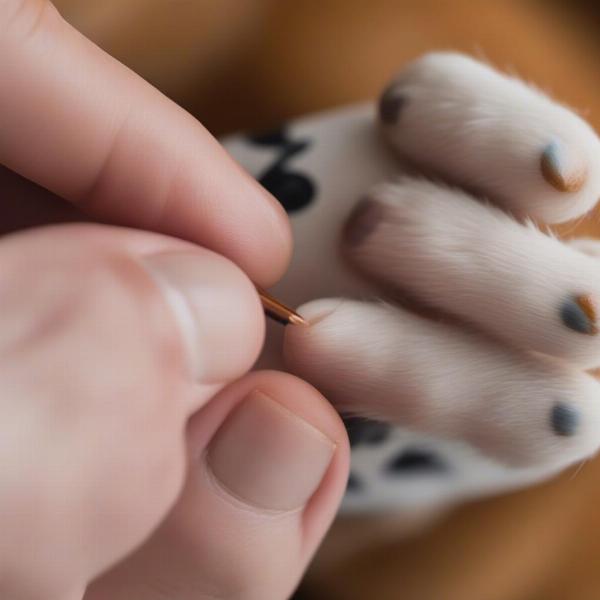Dog toe grips are a simple yet effective solution for improving your dog’s mobility and safety. Whether your dog is a senior struggling with arthritis, a young pup navigating slippery floors, or an active adventurer tackling challenging terrain, toe grips can provide the extra traction and support they need. These small, often rubbery, additions fit over your dog’s nails, providing a non-slip surface that helps prevent slips and falls. In this article, we’ll explore the benefits of dog toe grips, different types available, and how to choose the right ones for your furry friend.
Understanding the Benefits of Dog Toe Grips
Why would you consider dog toe grips for your canine companion? The advantages are numerous and can significantly enhance your dog’s quality of life, especially for senior dogs or those with mobility issues. Toe grips can:
- Improve Traction: Toe grips offer a secure grip on smooth surfaces like hardwood floors, tile, and even icy sidewalks, reducing the risk of slips and falls.
- Support Joint Health: By providing added stability, toe grips can lessen the strain on joints, particularly beneficial for dogs with arthritis or hip dysplasia.
- Protect Nails: Toe grips can act as a protective barrier for your dog’s nails, shielding them from wear and tear, especially during outdoor activities.
- Boost Confidence: For dogs experiencing mobility challenges, toe grips can restore confidence and encourage them to stay active.
- Prevent Scratching: Some toe grips can also minimize scratching on furniture and floors.
Choosing the Right Dog Toe Grips
With a variety of dog toe grips available on the market, selecting the appropriate type can seem daunting. Consider the following factors when making your choice:
- Size: Ensure a proper fit by accurately measuring your dog’s nails. Toe grips that are too tight can cause discomfort, while loose grips may fall off easily.
- Material: Look for durable, non-toxic materials like silicone or rubber.
- Purpose: Consider your dog’s specific needs. Are you primarily looking for indoor traction, outdoor protection, or both?
- Application: Some toe grips are adhesive, while others are designed to stay in place through friction.
Applying and Maintaining Dog Toe Grips
Applying dog toe grips is usually a straightforward process. Follow the manufacturer’s instructions carefully for the best results. For adhesive grips, ensure the nail surface is clean and dry before application. For friction-based grips, gently roll the grip onto the nail, ensuring a snug fit. Regular checks are essential to ensure the grips remain securely in place and are not causing any discomfort. Replace worn or damaged grips promptly.
 Applying dog toe grips to a dog's paw
Applying dog toe grips to a dog's paw
Are Dog Toe Grips Right for Your Dog?
Dog toe grips can be a valuable asset for many dogs, but they might not be suitable for every canine. Consult with your veterinarian if you have any concerns about your dog’s specific needs or health conditions. They can offer personalized advice on whether toe grips are a safe and effective option for your furry friend.
Conclusion
Dog toe grips offer a simple, practical solution for enhancing your dog’s traction, comfort, and overall well-being. By carefully considering your dog’s needs and selecting the right type of toe grips, you can help your canine companion navigate various surfaces with confidence and ease. You may also want to consider toe nail grips for dogs or sticky pads for dogs paws as alternatives.
FAQs
- How do I know what size toe grips my dog needs? Measure your dog’s nails according to the manufacturer’s guidelines.
- Can my dog wear toe grips all the time? While some dogs can wear them for extended periods, it’s crucial to monitor for any signs of discomfort and allow for regular breaks.
- Are toe grips difficult to apply? Most toe grips are designed for easy application, but always follow the manufacturer’s instructions.
- Can toe grips help my senior dog with arthritis? Yes, by providing added stability, toe grips can lessen joint strain and improve mobility for senior dogs.
- Are there different types of toe grips for different surfaces? While not specifically designed for different surfaces, some grips offer better traction on certain materials than others.
- How often should I replace my dog’s toe grips? Replace them as soon as they show signs of wear or damage.
- What if my dog loses a toe grip? While generally safe, consult your veterinarian if you suspect your dog has ingested a lost toe grip. For dogs with shorter legs, you may also be interested in weenie dog socks. Alternatively, dog gripping socks provide full paw coverage for better grip. You can also try wax on dog paws for added traction.
ILM Dog is a leading international online resource dedicated to providing expert advice on all aspects of dog care and wellbeing. We offer comprehensive information on dog breeds, health, training, nutrition, grooming, and much more. From puppy care to senior dog support, ILM Dog is your trusted companion on your dog ownership journey. For personalized guidance and expert tips, connect with us via email at [email protected] or call us at +44 20-3965-8624. ILM Dog is committed to helping you provide the best possible care for your beloved canine friend.